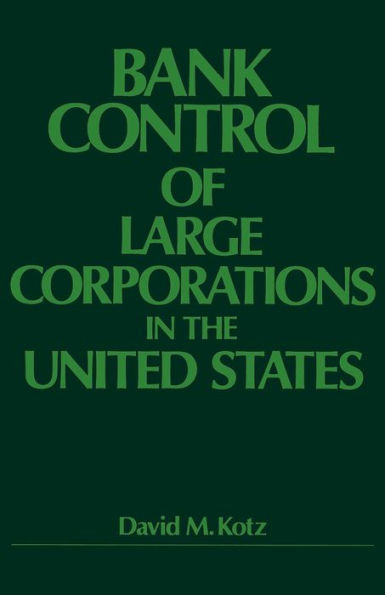Bank Control of Large Corporations in the United States
"Truly a distinguished piece of work, based on new data that had not been analyzed before. There is an excellent combination of historical perspective, conscientious examination of a great mass of data, and penetrating analysis."
—Robert Aaron Gordon, Charter Member of the Brookings Panel on Economic Activity
"Contends that since the Second World War, a small number of 'giant, well-established' banks in a few major cities have re-emerged as the major group that controls large corporations. Places the financial control thesis in historical perspective from the Civil War to the present and then examines the control of the two hundred largest U.S. corporations in 1967-69 in terms of owner control, financial control, and no identified center of control. Also comments on the means of exercising control. ... the author finds that a substantial portion of the largest nonfinancial corporations in 1967-69 were under the control of financial institutions; the control is exercised through the ownership of stock and the role of the bankers as creditors of the corporations."
—Journal of Economic Literature
"Recent empirical evidence, made available through congressional hearings, reveals that large banking groups are exercising substantial influence over nonfinancial corporations. This is accomplished through stockholdings, creditor relationships, and directorship ties. In this excellent historical statistical analysis, Katz assesses the extent and impact of such control in a competitive economy."
—Library Journal
"1102268110"
—Robert Aaron Gordon, Charter Member of the Brookings Panel on Economic Activity
"Contends that since the Second World War, a small number of 'giant, well-established' banks in a few major cities have re-emerged as the major group that controls large corporations. Places the financial control thesis in historical perspective from the Civil War to the present and then examines the control of the two hundred largest U.S. corporations in 1967-69 in terms of owner control, financial control, and no identified center of control. Also comments on the means of exercising control. ... the author finds that a substantial portion of the largest nonfinancial corporations in 1967-69 were under the control of financial institutions; the control is exercised through the ownership of stock and the role of the bankers as creditors of the corporations."
—Journal of Economic Literature
"Recent empirical evidence, made available through congressional hearings, reveals that large banking groups are exercising substantial influence over nonfinancial corporations. This is accomplished through stockholdings, creditor relationships, and directorship ties. In this excellent historical statistical analysis, Katz assesses the extent and impact of such control in a competitive economy."
—Library Journal
Bank Control of Large Corporations in the United States
"Truly a distinguished piece of work, based on new data that had not been analyzed before. There is an excellent combination of historical perspective, conscientious examination of a great mass of data, and penetrating analysis."
—Robert Aaron Gordon, Charter Member of the Brookings Panel on Economic Activity
"Contends that since the Second World War, a small number of 'giant, well-established' banks in a few major cities have re-emerged as the major group that controls large corporations. Places the financial control thesis in historical perspective from the Civil War to the present and then examines the control of the two hundred largest U.S. corporations in 1967-69 in terms of owner control, financial control, and no identified center of control. Also comments on the means of exercising control. ... the author finds that a substantial portion of the largest nonfinancial corporations in 1967-69 were under the control of financial institutions; the control is exercised through the ownership of stock and the role of the bankers as creditors of the corporations."
—Journal of Economic Literature
"Recent empirical evidence, made available through congressional hearings, reveals that large banking groups are exercising substantial influence over nonfinancial corporations. This is accomplished through stockholdings, creditor relationships, and directorship ties. In this excellent historical statistical analysis, Katz assesses the extent and impact of such control in a competitive economy."
—Library Journal
—Robert Aaron Gordon, Charter Member of the Brookings Panel on Economic Activity
"Contends that since the Second World War, a small number of 'giant, well-established' banks in a few major cities have re-emerged as the major group that controls large corporations. Places the financial control thesis in historical perspective from the Civil War to the present and then examines the control of the two hundred largest U.S. corporations in 1967-69 in terms of owner control, financial control, and no identified center of control. Also comments on the means of exercising control. ... the author finds that a substantial portion of the largest nonfinancial corporations in 1967-69 were under the control of financial institutions; the control is exercised through the ownership of stock and the role of the bankers as creditors of the corporations."
—Journal of Economic Literature
"Recent empirical evidence, made available through congressional hearings, reveals that large banking groups are exercising substantial influence over nonfinancial corporations. This is accomplished through stockholdings, creditor relationships, and directorship ties. In this excellent historical statistical analysis, Katz assesses the extent and impact of such control in a competitive economy."
—Library Journal
28.95
In Stock
5
1

Bank Control of Large Corporations in the United States
232
Bank Control of Large Corporations in the United States
232Paperback(First Edition)
$28.95
28.95
In Stock

Product Details
| ISBN-13: | 9780520039377 |
|---|---|
| Publisher: | University of California Press |
| Publication date: | 05/09/1980 |
| Edition description: | First Edition |
| Pages: | 232 |
| Product dimensions: | 5.50(w) x 8.50(h) x 0.60(d) |
About the Author
From the B&N Reads Blog
